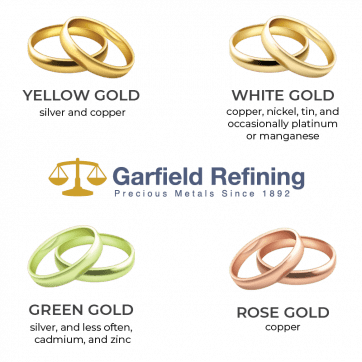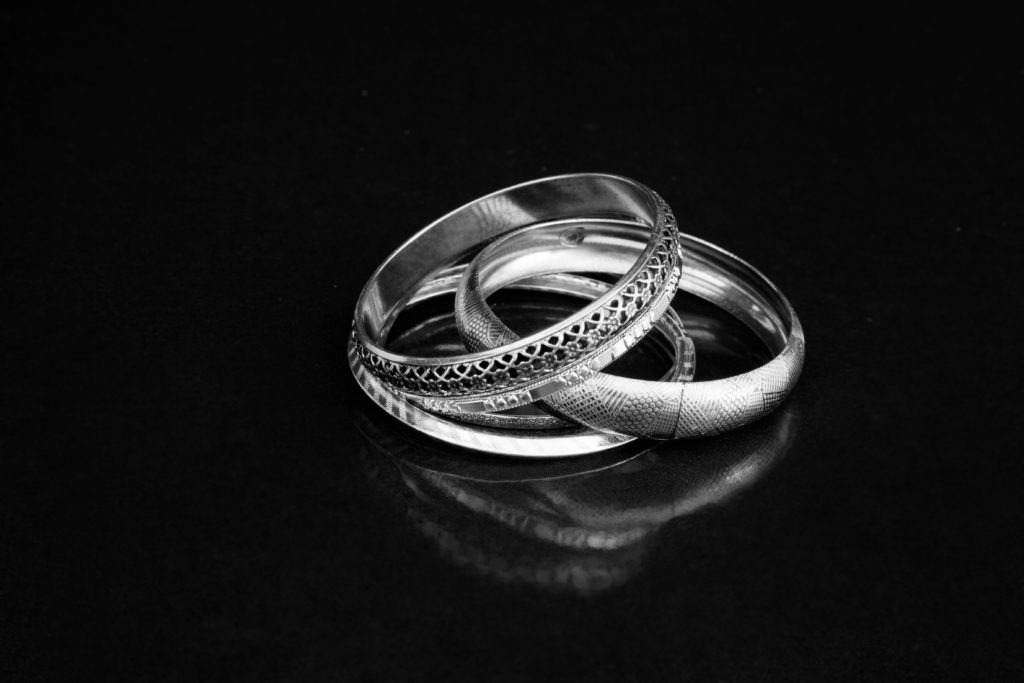Simply put, an alloy is a mixture of two or more metals. The word “alloy” comes from the Latin “ligare,” meaning “to bind” or “unite.” As both a noun and a verb, it can describe either the process of combining metals or the resulting mixture itself. Precious metals such as platinum, palladium, gold and silver are commonly alloyed with metals like copper, nickel, or zinc to optimize the physical properties of the end product.
For example, since pure gold is very soft, it’s often alloyed with silver, copper, zinc or other metals to increase strength and durability in jewelry, dental implants and more. When it comes to different types of alloys, the possibilities are endless. Precious metals can be combined with other precious metals, or with non-precious metals aka “base metals.”
The primary metal in any alloy is called the base or solvent. Secondary alloy elements are called solutes, and undesirable elements are referred to as impurities.
Stronger Together: Benefits of Creating Alloys
Alloys are all around us—from jewelry and coins to dental implants, electronics and more. In fact, more than 90% of commercial metals are alloys!
Here are some examples of the advantages alloys can have over pure metals:
- Improved corrosion resistance
- Better heat resistance
- Increased strength and durability
- Unique electrical or magnetic properties
- Greater cost-effectiveness
Naturally Occurring Alloys
Although we typically think of alloys as man-made, there are a few types that occur in nature. One of the first to be discovered was electrum (aka “green gold”), a naturally-occurring alloy of gold and silver, sometimes containing trace amounts of copper or other metals. Electrum has been found in regions that contain both gold and silver deposits, such as ancient Egypt and Greece. The color ranges from pale yellow to greenish, and this alloy was historically used in ancient coins and artifacts.
Another example of a natural alloy is “porpezite,” which contains significant amounts of both gold and palladium. This soft pale metal is quite rare, found in certain placer deposits, especially in Colombia. While naturally-occurring alloys are fascinating, they only make up a very small percentage of the alloys we use today.
Familiar Precious Metals Alloys
Here are some common examples of precious metals alloys:
- Sterling silver: Composed of 92.5% silver and 7.5% copper. Adding copper makes it more durable for use in jewelry and silverware.
- White gold: Typically 75% gold, 25% nickel and zinc, designed to mimic the look of platinum.
- Rose gold: Made from gold and copper, sometimes with small amounts of silver. The copper creates its distinctive pink hue.
Other well-known precious metals alloys include 18-karat gold, 14-karat gold, Britannia silver, platinum sterling, and titanium gold.
Beyond Precious Metasl Alloys
While these alloys don’t contain precious metals, they’re so widely used that we think they’re worth mentioning:
- Stainless steel: Primarily iron with at least 10.5% chromium, as well as nickel, carbon, and other elements. The chromium provides corrosion resistance.
- Bronze: Copper and tin. Copper usually makes up about 88-90%, and tin comprises about 10-12%. The copper creates the reddish-brown color and creates desired traits like high thermal and electrical conductivity.
- Brass: Primarily copper and zinc – about 55-95% copper, 5-45% zinc. Other metals are sometimes included too, like lead, tin, iron and aluminum.


Alloys in Jewelry
Alloys open up a range of creative possibilities in jewelry design, affecting color, strength, and cost. Most high-grade jewelry alloys will last a lifetime when properly cared for – alloys can have triple the strength of a pure metal on its own!
Gold alloys are classified using karats, a 24-part rating system that’s rooted in historical goldsmithing practices. Here’s a quick look at karat ratings:
- 24k (pure gold): at least 99.95% gold by weight; 24 parts gold
- 18k: at least 75.00% gold by weight; 18 parts gold to 6 parts other metal
- 14k: at least 58.33% gold by weight; 14 parts gold to 10 parts other metal
- 10k: at least 41.67% gold by weight; 10 parts gold to 14 parts other metal
Dental Alloys
Gold has been used in dentistry for thousands of years and is still prized today for its exceptional durability and biocompatibility. Silver, platinum and palladium also offer similar benefits. These precious metals are used in dental implants such as crowns, bridges, PFMs inlays, onlays and more. Base metals such as copper, zinc, titanium and more are often alloyed with the precious metals – this helps to offset costs and strengthen the material.
The American Dental Association classifies dental alloys in the following groups:
- High noble: minimum of 60% precious metals, primarily gold
- Noble: at least 25% precious metals
- Predominantly base: less than 25% precious metals
While alternatives to dental metals (such as ceramic, composite resins, e.max, etc) have become increasingly popular, precious metals are still preferred in some cases due to their strength and biocompatibility.
Industrial Uses of Precious Metals Alloys
Alloys containing gold, silver, and palladium are often used in devices like smartphones and laptops because they offer great conductivity, resistance to corrosion and reliability in high-frequency signals. Gold and palladium are commonly used in connectors and switches. Fun fact: each of the 1.5 billion smart phones sold every year contain a small amount of gold!
The technology sector, though significant, only makes up about 7-9% of gold’s global demand. Demand is dominated by the jewelry industry, followed by central bank purchases and investment (bullion).
Precious metals alloys are also used in tons of cool things besides our handheld devices – from jet engines and spacecraft to medical devices, catalytic converters, electric vehicles, chemical manufacturing equipment and even glass production.


What Is My Precious Metals Alloy Worth?
Because precious metals alloys are so variable by nature, their value can range widely. For example, a lower-grade jewelry alloy such as 10-karat gold will be worth a lot less than a 22-karat gold ring. (But with gold’s record-breaking prices lately, even just a small amount of gold can be worth a lot!)
It’s also important to know whether your alloy contains more than one precious metal. Jewelry and dental material often contain gold, silver and/or palladium, all of which impact the value.
Alloys and Refining
Because alloys vary widely, so does their value. The best way to determine your alloy’s value is through refining, which isolates each metal. Garfield Refining accepts jewelry, dental scrap, and other items containing precious metals, recovering and recirculating these metals in more purified forms. Precious metals refining is akin to a recycling method; it can recover precious metals from almost any organic material.
For example, if you send us a gold alloy that’s 92.5% gold and 7.5% silver, we’ll isolate the two elements. Then you’ll be paid for each metal based on their daily market prices.
If you’re interested in selling your precious metals alloy, Garfield Refining can help you get the highest payment for your items. Even if you’re unsure of your item’s exact composition, give us a call—our knowledgeable team is here to help, free of charge!
Ready to sell your precious metals? Start your shipment today!
